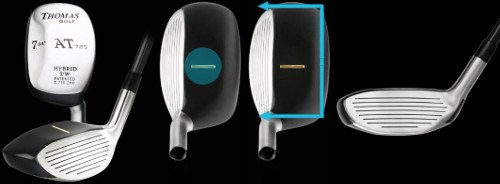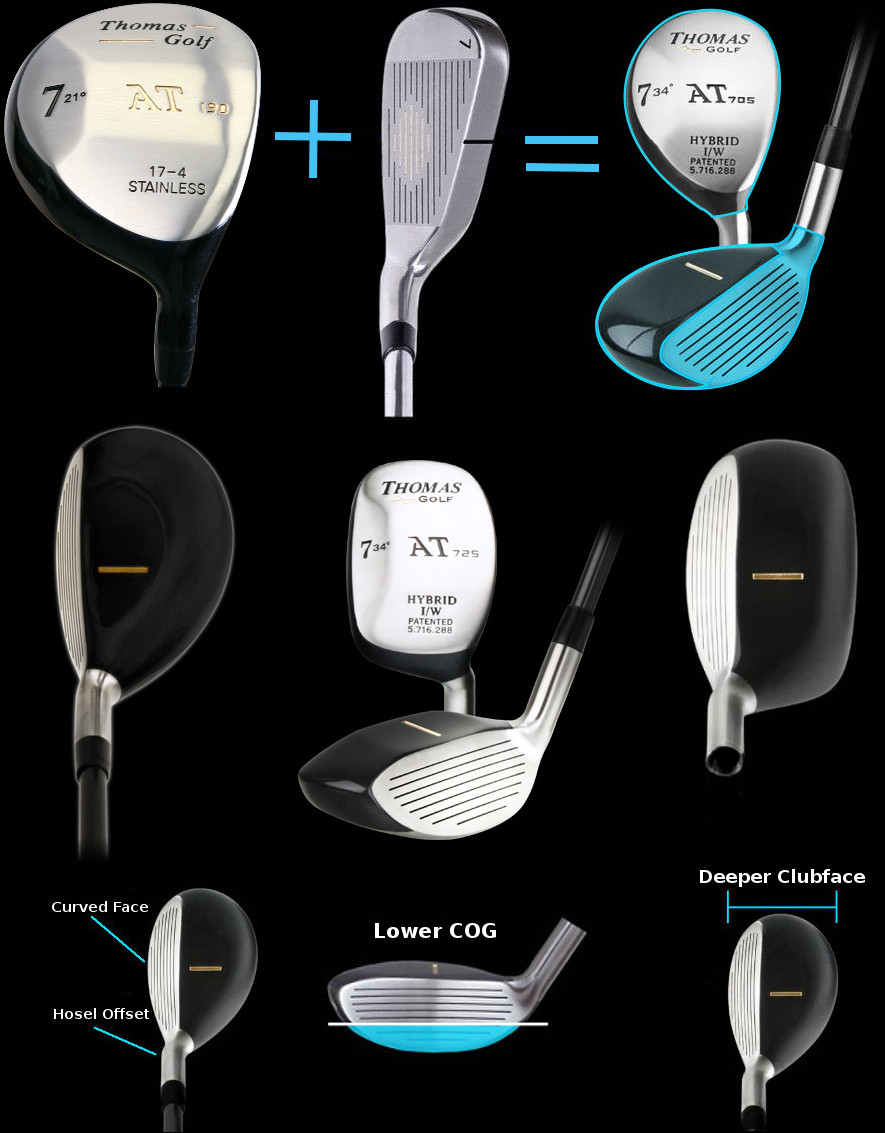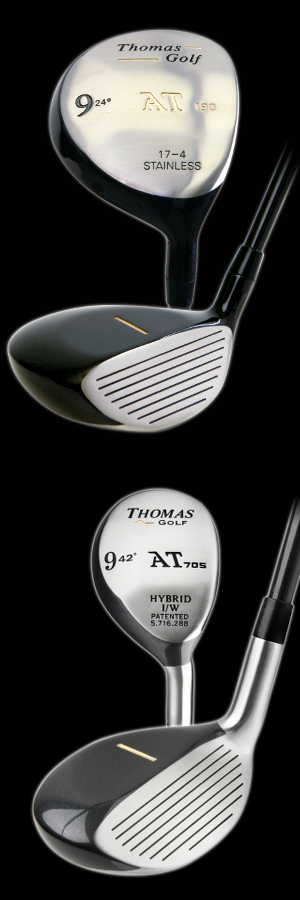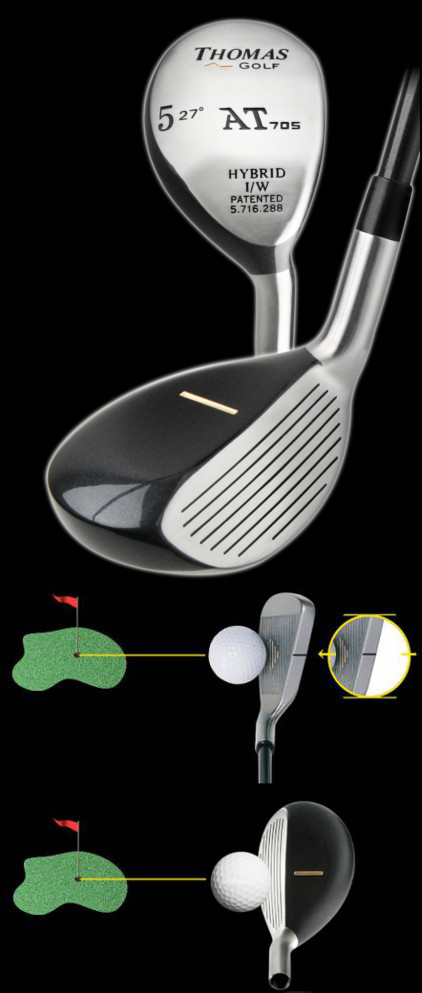When replacing your Irons or Woods with an easier to hit Hybrid Club, it is important to select the correct Hybrid for each club you are replacing. Likewise, attention is required if your set is going to contain a mixture of Hybrids from different brands. In both cases, the key number to focus on is the Loft of the club. If you want a Hybrid to replace an existing Iron, select a Hybrid with a similar loft (sometimes this requires ignoring the club #, as brands will assign club #'s in very different ways). Likewise, if you are looking for a Hybrid that goes 10-15 yards shorter than a Hybrid currently in your bag, then select a Hybrid with about 3-4 more degrees of loft as the one in your bag.  You need to know which hybrids deliver the same distance and trajectory as the clubs your are replacing. The chart below shows exactly which hybrids in the Thomas Golf AT-705 lineup should replace which irons and woods in your bag.
You need to know which hybrids deliver the same distance and trajectory as the clubs your are replacing. The chart below shows exactly which hybrids in the Thomas Golf AT-705 lineup should replace which irons and woods in your bag.
Factors considered include the clubhead loft, shaft length and average distance of each club (not shown as it varies from golfer to golfer). Because specifications differ between hybrid models and manufacturers, the chart isn't meant to be used as a general guide to all hybrids. Always refer to the specific loft, length and lie characteristics of the hybrids you're considering before deciding which irons or woods to replace.
| Thomas AT705 | Loft | Lie | Length (graphite) | Length (steel) | Replaces Thomas: |
| Hybrid Driver | 10.5° | 56° | 43.5" | 42.5" | Traditional Driver |
| 1 Hybrid Iron | 16° | 57° | 40.5" | 40" | 1 Iron / 4 wood |
| 2 Hybrid Iron | 18° | 58° | 40" | 39.5" | 2 Iron / 5 wood |
| 3 Hybrid Iron | 21° | 59° | 39.5" | 39" | 3 Iron / 7 wood |
| 4 Hybrid Iron | 24° | 60° | 39" | 38.5" | 4 Iron / 9 wood |
| 5 Hybrid Iron | 27° | 61° | 38.5" | 38" | 5 Iron / 11 wood |
| 6 Hybrid Iron | 30° | 61.5° | 38" | 37.5" | 6 Iron / 13 wood |
| 7 Hybrid Iron | 34° | 62° | 37.5" | 37" | 7 Iron / 15 wood |
| 8 Hybrid Iron | 38° | 62° | 37" | 36.5" | 8 Iron / 17 wood |
| 9 Hybrid Iron | 42° | 63° | 36.5" | 36" | 9 Iron / 19 wood |
| PW Hybrid | 46° | 63° | 36" | 36" | PW / 21 wood |
| GW Hybrid | 50° | 64° | 36" | 36" | GW / 23 wood |
| SW Hybrid | 55° | 64° | 36" | 36" | SW / 25 wood |
| LW Hybrid | 60° | 64° | 36" | 36" | LW |
Since the Rules of Golf allow you to use only 14 clubs, it’s important not to carry two or more clubs with similar performance qualities. For instance, if you’ve got two clubs that produce a carry distance of 180 yards, you’re essentially wasting one of your 14 spots. The introduction of hybrid clubs has been a boon to golfers of all abilities. But adding one or more hybrids to your set can cause confusion. Assuming you’ve already got 14 clubs, which do you take out to make room for the new hybrids? The chart below offers a handy guide to replacing your irons or woods with Thomas Golf’s AT 725 Hybrid clubs. The chart accounts for factors such as clubhead loft, shaft length and the average shot distance each club produces. This chart uses exact specifications for the Thomas Golf AT 725 Hybrid lineup, which may feature different specs from hybrids made by other companies. Always refer to the manufacturer’s suggestions when replacing one club with another.
The chart below offers a handy guide to replacing your irons or woods with Thomas Golf’s AT 725 Hybrid clubs. The chart accounts for factors such as clubhead loft, shaft length and the average shot distance each club produces. This chart uses exact specifications for the Thomas Golf AT 725 Hybrid lineup, which may feature different specs from hybrids made by other companies. Always refer to the manufacturer’s suggestions when replacing one club with another.
| Thomas AT725 | Loft | Lie | Length (graphite) | Length (steel) | Replaces a Thomas : |
| Hybrid Driver 230cc | 10.5° | 56° | 43.5" | 42.5" | Traditional Driver |
| 1+ Hybrid Iron | 14° | 56° | 41" | 40.5" | 3 wood |
| 1 Hybrid Iron | 16° | 57° | 40.5" | 40" | 1 Iron / 4 wood |
| 2 Hybrid Iron | 18° | 58° | 40" | 39.5" | 2 Iron / 5 wood |
| 3 Hybrid Iron | 21° | 59° | 39.5" | 39" | 3 Iron / 7 wood |
| 4 Hybrid Iron | 24° | 60° | 39" | 38.5" | 4 Iron / 9 wood |
| 5 Hybrid Iron | 27° | 61° | 38.5" | 38" | 5 Iron / 11 wood |
| 6 Hybrid Iron | 30° | 61.5° | 38" | 37.5" | 6 Iron / 13 wood |
| 7 Hybrid Iron | 34° | 62° | 37.5" | 37" | 7 Iron / 15 wood |
| 8 Hybrid Iron | 38° | 62° | 37" | 36.5" | 8 Iron / 17 wood |
| 9 Hybrid Iron | 42° | 63° | 36.5" | 36" | 9 Iron / 19 wood |
| PW Hybrid | 46° | 63° | 36" | 36" | PW / 21 wood |
| GW Hybrid | 50° | 64° | 36" | 36" | GW / 23 wood |
| SW Hybrid | 55° | 64° | 36" | 36" | SW / 25 wood |
| LW Hybrid | 60° | 64° | 36" | 36" | LW |
What is a Hybrid Golf Club?
Once you have purchased your first hybrid wood the first question you need to find the answer to is when to use it. Like almost any club in your bag, it can be used for a multitude of shots. One club does not equal one type of shot. Therefore, look into the reasons why you absolutely should use the hybrid wood in some situations and also, make it’s unique characteristics work for you in creative ways.
Some of you are going to wince when I use the phrase moment of inertia, or MOI. Please, don’t stop reading! Moment of inertia is important in golf club design and the concept can help you decide which clubs to use in different situations.
Moment of inertia has to do with where the weight is positioned in the golf club and the forgiveness factor that it affords. Modern woods normally have the weight placed well back in the head, away from the face.
Imagine you are standing in a strong wind and holding a propeller in your hand. The majority of weight in a propeller is in the center so the propellers rotate very easily in the wind.
Now, apply weight to each of the propellers so that each is heavier than the center of the propeller. It will be much more difficult for the wind to rotate the propellers because the weight is further away from the center.
Imagine now the weight in your golf club is right behind the center of your clubface. The club face will rotate easily if the ball contacts the club on the toe or the heel, like your first propeller. Locate that weight further away from the center of the face and your have less club rotation and more forgiving shots when contact is away from the clubface. Putting the weight near the back of the club, the way hybrids are designed, will reduce the rotation. Place the weight near the back of the club AND low in the club and you will have forgiving shots that will get into the air very quickly.
The hybrid was originally designed to hit the ball out of the rough easier than irons or a fairway wood. It’s safe to say that this would be the optimal situation to use a hybrid wood. But a hybrid can be much more than a one-hit wonder for you.
If you dread lengthier par 3’s because you have to hit a long iron, then a hybrid is a great substitute. If you have a 4 hybrid in order to replace a 4-iron, the 4 hybrid shaft is a bit longer than a 4-iron, so it will carry a bit more. But because of the weight distribution the trajectory of the shot will be higher and therefore easier to get the ball to stay on the green. Finally, because there is not much rotation in a hybrid wood, you may find your misses closer to the green, avoiding the bunkers, water, etc., that routinely surround the greens on par 3’s.
Chipping with a hybrid is an outstanding alternative to chipping with and iron. If you play a course that has finely mowed, long aprons then it’s much easier to bump up a hybrid than to try to putt. It requires a smaller motion. It’s also easier than irons, especially wedges, because it’s much easier to control the ball when it’s on or close to the ground. Choke down on the hybrid, play it a little forward and move your weight more towards your left foot. Use your putting motion and you have a very reliable chip shot in your bag.
When to Use Hybrid Clubs
Most people are familiar with fairway woods, but what is it that makes them tick? Fairway woods have long been a staple in golf. It requires a skilled player to hit a driver off of the ground. The lack of loft on the driver made it difficult to get the ball into the air. The modern driver heads are even tougher to hit off of the ground because they are so big the club tends to bounce into the ball.
A fairway wood has a smaller head and a more shallow face than a driver, so it’s a convenient club to hit when you need length. It’ also easy to hit off of a tight lie because the bottoms are flat and they tend not to bounce as long as you aren’t very steep on your downswing.
The fairway wood shafts are longer than hybrids which should add distance to the shots but also slightly decrease the controllability of the club. The center of gravity is closer to the face than a hybrid and combined with the low lofts, makes distance the ultimate benefit in using a fairway wood. Fairway woods are also excellent off of the tee when you still need length but require more accuracy than your driver will deliver. The added loft cuts down on the sidespin making it easier to keep the ball in play.
Because fairway wood heads are a little bigger and longer than hybrids, the hybrids have found their own nitch in the golf club market. The smaller and more curved hybrid head makes them easy to slide through the rough. The weight is positioned away from the clubface and lower than other wood-type clubs. The high launch angle produced by the position of the weight makes the hybrid a perfect club to use out of the tall grass.
The hybrid is not at all obsolete from the fairway however. Even though the bottom of the club is slightly curved, the head is small so the chance of bouncing is slim. Players who navigate Northern courses with their thicker grasses will find that they love the hybrids so much they may find there is no reason to have fairway woods or long irons in their bags.
Hybrids are also excellent when playing long par 3’s. Fairway woods are great for length but difficult to keep on the green. With the weight positioned low you can hit a hybrid of similar loft as a fairway wood much higher. The shorter shaft also makes it a little easier to control but the distance will be slightly less than its similarly lofted fairway wood. Out of a bunker the hybrid is a champ. The small head is an advantage as is the higher launch angle. The goal is to get out of the bunker, right?
There is no clear winner in the the fairway wood vs. the hybrid contest. Both were developed because there was a specific need. Fairway woods are great when you need length and you have a fairly good lie. Hybrids work well out of the rough but can also offer an advantage on par threes and even out of the fairway. It’s also much easier to hit a hybrid out of a bunker than a fairway wood!
If you want the most versatile of the two my vote goes for the hybrid simply because there aren’t many downfalls to using it in many different capacities.
Fairway Wood vs Hybrid
There have been many changes in golf over the decades. Many agree the change from wooden shafts to steel was the most significant change in golf equipment.
The significance of other changes depends on your point of view. The sand wedge, graphite shafts and heel to toe weighting have all impacted the way we play the game. One of the most overlooked improvements in golf clubs is the advantages that hybrid irons offer over standard irons.
All golfers look for game improvement but at the same time most are a little picky about what clubs they put into their bags. Thinking about a new set of irons or hybrid irons is a major commitment. Before you leap at a set take the time to consider which style of clubs will benefit you most.
A player’s swing technique helps determine the ability to hit the sweet spot of an iron. The player’s swing also affects the height or trajectory the ball has after a shot. The better the swing, the more repeatable the shot becomes in both distance, height, and accuracy.
If you rarely break into the 90’s you might be a good candidate for hybrid irons. The par shooter may only desire one or two hybrid irons, while the high-handicapper may be wise to use a full set.
With the long irons even the most talented of golfers can use the assistance of a game improvement hybrid iron. Ernie Els, the Big Easy, plays with two hybrid irons in his golf bag. If he can see the advantages of the hybrid iron, we all need to take an honest appraisal of our golf games and figure out where we can fit one into our bags.
Golf club manufactures offer an astounding amount of iron options to us. There are blended sets of 2-6 irons being hybrid golf irons, while the irons and wedges are more conventional looking irons.
Also out there are progressive hybrids that have fatter heads in the longer clubs and then thin out slightly through the wedge.
Many hybrid sets have progressive offsets in the irons. That means the pitching wedge and shorter length irons will have less offset than the longer length irons, where more offset is needed. In theory the more offset a golf club is, the more the player’s hands will stay in front of the golf ball at impact. Often the more talented player will not need offset, as his/her hands are already in front of the ball at impact.
A person’s talent level and giving an honest appraisal of one’s game, can help determine how many hybrid irons a person needs in their arsenal of clubs.
Many manufactures no longer make #1 or even #2 irons. Those clubs have become obsolete due to the forgiveness of hybrid golf irons. It makes sense for everyone to use some combination of hybrid golf irons in their set of clubs. After all, if the top manufactures do not make long irons for the best players in the world, there’s a reason for that.
Keep in mind any combination of hybrid irons can work in your set. Your clubhead speed will determine the lowest loft you can hit out of rough with a trajectory that will stop on a green. The lower your club head speed the more hybrid golf irons you need in your set.
The offset needs to match either your skill level or look you enjoy.
Consider the benefits of hybrid long irons and traditional short irons when deciding on hybrid irons vs. regular irons.
If you need a testament to adding at least 1 hybrid iron then consider that 70% of the most talented players on tour have one or more hybrid golf irons in their set!
Hybrid Irons vs Regular Irons
When weighing your options between hybrids and irons you really should consider the distances you hit the clubs already in your bag. There is nothing worse than to dread a 180 yard shot because the clubs you hit closest to that distance are 170 or 200 yards. Thirty yards is a gaping hole and could cost you strokes.
Write down the average distances you hit your clubs and look for gaps. Your goal should be to have no more than a 10-15 yard gap. Now you have a place to start shopping from. As always, make sure you are able to try new clubs before you buy them. It’s only prudent when you are trying to build a balanced set of clubs and everyone hits different clubs different distances. High handicappers should automatically consider replacing their 5 iron through 3 iron with hybrids.
Hybrids are very forgiving and will have a higher trajectory than irons because of their weighting. The hybrids will carry longer than irons and roll less. Irons today are easier to hit than ever but the heads are not as deep front to back. The further back you can place the weighting the more forgiving the club will become. An off-center hit with a hybrid will give you more distance because of that forgiveness. Finally, it can be argued that most high handicap golfers have a shallow downswing. Irons that come down too shallow will result in chunky shots whereas hybrids will not stick into the grass easily. The major drawback in using hybrids is that they are so forgiving it’s hard to tell where you are missing your shots. Many high handicappers could not care less where their missed are as long as the shot ends up around the same distance if they had hit it in the center of the clubface. Lower handicap players, on the other hand, appreciate feedback. Irons make it easier to feel ball contact and therefore make adjustments.
If a good player wishes to create ball flight depending on the situation then it is an advantage to use irons. The weight distribution in hybrids makes it challenging to close and open the clubface willingly. Irons shots have a lower trajectory and will roll further, which is another advantage to shot making. As the professionals have demonstrated, though, hybrids are a viable option to long irons. They are just so darn easy to hit and good players can hit them a long way. The extra inches on the club and the club head mass coupled with the sheer power of their golf swings allow golfers to swing easier and hit it farther.
Each player has preferences when looking down at the club in their hands. I don’t know too many who will argue that when you see a mini wood head you imagine you will get more distance than you would with an iron.
Other situations when considering hybrid golf clubs vs irons distance are how much distance you really need and what type of courses do you play. How high do you need to hit it? Do you need to scrape out every yard you can get or is accuracy your biggest issue? Do you need to fill in for clubs that go 160 yards or 190 yards?
Evaluate your game and evaluate your clubs to help you decide whether hybrids or irons will go the distance for you.
Hybrid Golf Clubs vs Irons Distance
The hybrid wood debuted in the golf market about 20 years ago. It was considered a club that would be used by an average golfer who had trouble getting irons into the air. There had been hybrid-type clubs previously, but this unique hybrid was truly a blend of irons and woods. The hybrid wood is not the first specialty club that achieved longevity in golf.
Gene Sarazen renovated the sand wedge in the 1930’s adding features that we still use today in modern wedges. A flange was added for forgiveness and weight was added to the flange. Loft was also increased in the sand wedge to make a club that made it easy to hit the ball in the air with more forgiveness than the straight-edged clubs used before that time. The sand wedge makes the game easier and more fun for professionals and amateurs alike.
The hybrid golf club was made with a similar concept in mind. The mini-fairway wood was made with a smaller head than a fairway wood, a lower center of gravity than an iron and a wide face like a wood. Together those characteristics make for a very controllable golf club. And like the sand wedge, the club can now be found in the bags of amateurs as well as professionals.
Have you ever faced a shot from the rough where you wouldn’t consider hitting a fairway wood, but you know an iron would be difficult to get through the grass? What about standing on a long par 3 knowing the iron you need to hit has no chance of staying on the green? The hybrid wood was made for these circumstances and now they are on the verge of replacing fairway woods as well.
Consider these general specifications for hybrid woods:
- Hybrids come in lofts of 15 degrees and higher.
- Hybrid club numbers are made to correspond with iron numbers. (3 hybrid=3 iron)
- Most hybrids have graphite shafts which are lighter and will allow you to swing faster.
- Hybrid shaft lengths are longer than irons and shorter than fairway woods.
- As mentioned before, hybrids have a low center of gravity which provides a higher launch angle. It will get out of the grass very quickly.
- Hybrids are perimeter weighted and therefore create spin to bring your missed shots back towards center.
- Comparing the hybrid shaft to the iron shaft, the hybrid shaft is longer and the shot distance is slightly longer.
- Comparing the fairway wood to a hybrid, the hybrid shaft is shorter and the distance will be slightly shorter.
- Average hybrid shaft length is 39-41
If you decide to add a hybrid to your bag, or perhaps try one out, look through the clubs you have already. If you have a mid-long iron or a fairway wood that doesn’t work very well, then replace it with a similar lofted hybrid.
If you have a gap in your yardages and you can afford to take a club out, then fill your gap with the corresponding loft hybrid. Important to note, you should try the hybrid first before you buy it if you can. Not all hybrids are made alike, just as all drivers have their own characteristics.













